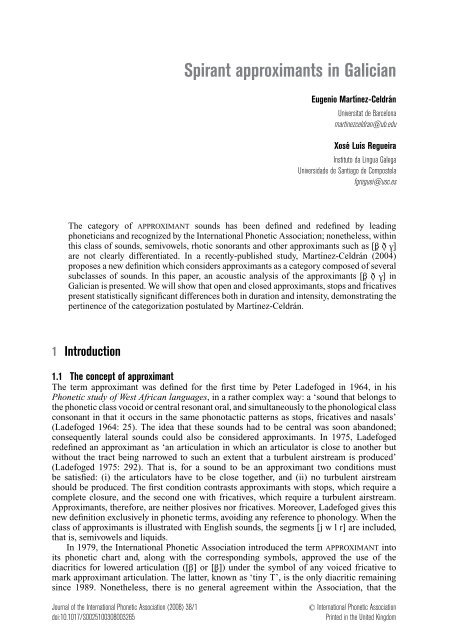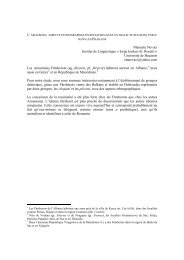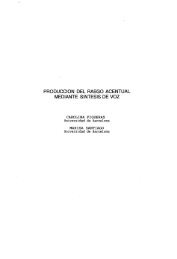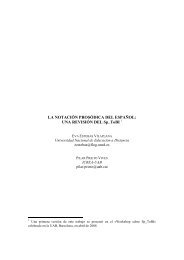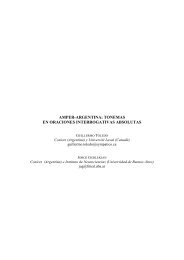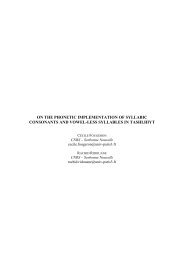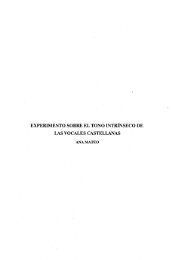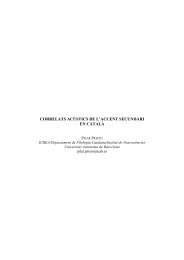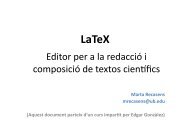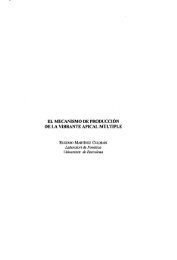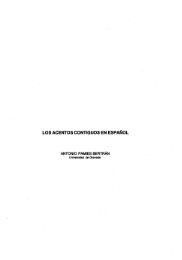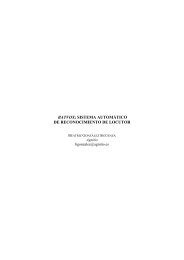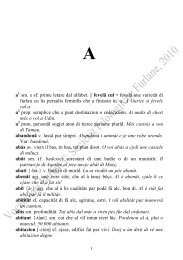Spirant approximants in Galician - ResearchGate
Spirant approximants in Galician - ResearchGate
Spirant approximants in Galician - ResearchGate
Create successful ePaper yourself
Turn your PDF publications into a flip-book with our unique Google optimized e-Paper software.
<strong>Spirant</strong> <strong>approximants</strong> <strong>in</strong> <strong>Galician</strong><br />
Eugenio Martínez-Celdrán<br />
Universitat de Barcelona<br />
mart<strong>in</strong>ezceldran@ub.edu<br />
XoséLuís Regueira<br />
Instituto da L<strong>in</strong>gua Galega<br />
Universidade de Santiago de Compostela<br />
fgreguei@usc.es<br />
The category of APPROXIMANT sounds has been def<strong>in</strong>ed and redef<strong>in</strong>ed by lead<strong>in</strong>g<br />
phoneticians and recognized by the International Phonetic Association; nonetheless, with<strong>in</strong><br />
this class of sounds, semivowels, rhotic sonorants and other <strong>approximants</strong> such as [B§ D§ V§]<br />
are not clearly differentiated. In a recently-published study, Martínez-Celdrán (2004)<br />
proposes a new def<strong>in</strong>ition which considers <strong>approximants</strong> as a category composed of several<br />
subclasses of sounds. In this paper, an acoustic analysis of the <strong>approximants</strong> [B§ D§ V§] <strong>in</strong><br />
<strong>Galician</strong> is presented. We will show that open and closed <strong>approximants</strong>, stops and fricatives<br />
present statistically significant differences both <strong>in</strong> duration and <strong>in</strong>tensity, demonstrat<strong>in</strong>g the<br />
pert<strong>in</strong>ence of the categorization postulated by Martínez-Celdrán.<br />
1 Introduction<br />
1.1 The concept of approximant<br />
The term approximant was def<strong>in</strong>ed for the first time by Peter Ladefoged <strong>in</strong> 1964, <strong>in</strong> his<br />
Phonetic study of West African languages, <strong>in</strong> a rather complex way: a ‘sound that belongs to<br />
the phonetic class vocoid or central resonant oral, and simultaneously to the phonological class<br />
consonant <strong>in</strong> that it occurs <strong>in</strong> the same phonotactic patterns as stops, fricatives and nasals’<br />
(Ladefoged 1964: 25). The idea that these sounds had to be central was soon abandoned;<br />
consequently lateral sounds could also be considered <strong>approximants</strong>. In 1975, Ladefoged<br />
redef<strong>in</strong>ed an approximant as ‘an articulation <strong>in</strong> which an articulator is close to another but<br />
without the tract be<strong>in</strong>g narrowed to such an extent that a turbulent airstream is produced’<br />
(Ladefoged 1975: 292). That is, for a sound to be an approximant two conditions must<br />
be satisfied: (i) the articulators have to be close together, and (ii) no turbulent airstream<br />
should be produced. The first condition contrasts <strong>approximants</strong> with stops, which require a<br />
complete closure, and the second one with fricatives, which require a turbulent airstream.<br />
Approximants, therefore, are neither plosives nor fricatives. Moreover, Ladefoged gives this<br />
new def<strong>in</strong>ition exclusively <strong>in</strong> phonetic terms, avoid<strong>in</strong>g any reference to phonology. When the<br />
class of <strong>approximants</strong> is illustrated with English sounds, the segments [j wlr] are <strong>in</strong>cluded,<br />
that is, semivowels and liquids.<br />
In 1979, the International Phonetic Association <strong>in</strong>troduced the term APPROXIMANT <strong>in</strong>to<br />
its phonetic chart and, along with the correspond<strong>in</strong>g symbols, approved the use of the<br />
diacritics for lowered articulation ([B] or[B§]) under the symbol of any voiced fricative to<br />
mark approximant articulation. The latter, known as ‘t<strong>in</strong>y T’, is the only diacritic rema<strong>in</strong><strong>in</strong>g<br />
s<strong>in</strong>ce 1989. Nonetheless, there is no general agreement with<strong>in</strong> the Association, that the<br />
Journal of the International Phonetic Association (2008) 38/1<br />
doi:10.1017/S0025100308003265<br />
C○ International Phonetic Association<br />
Pr<strong>in</strong>ted <strong>in</strong> the United K<strong>in</strong>gdom
52 E. Martínez-Celdrán & X. L. Regueira<br />
category of <strong>approximants</strong> conta<strong>in</strong>s a set of subclasses. Currently, the Association itself (IPA<br />
1999) has separated lateral <strong>approximants</strong> from other <strong>approximants</strong>, but the subclasses of<br />
semiconsonants (or semivowels), rhotic sonorants and non-rhotic obstruent consonants are all<br />
mixed <strong>in</strong> under <strong>approximants</strong> on the pulmonic sounds chart with no dist<strong>in</strong>ction made among<br />
them. From a general phonetics standpo<strong>in</strong>t, <strong>in</strong>clud<strong>in</strong>g the semivowels <strong>in</strong> the set of consonants<br />
is rather contradictory <strong>in</strong> and of itself.<br />
In a recent article published <strong>in</strong> the Journal of the International Phonetic Association,<br />
Martínez-Celdrán (2004) presents a solution for all these contradictions. He postulates that<br />
APPROXIMANT is a super-category that <strong>in</strong>cludes lateral and rhotic sounds, semivowels, and a<br />
set of obstruent consonants such as [B§ D§ J§ V§] that have no specific name, and for which the<br />
author proposes the label SPIRANTS, follow<strong>in</strong>g Mart<strong>in</strong>et (1956). In Martínez-Celdrán’s article<br />
a new def<strong>in</strong>ition for <strong>approximants</strong> is proposed, because <strong>in</strong> some studies there is evidence that<br />
the difference between fricatives and <strong>approximants</strong> does not actually lie <strong>in</strong> a different degree<br />
of articulatory stricture. Romero (1995: 130) asserts that ‘there is no reliable difference <strong>in</strong><br />
constriction degree between fricatives and [spirant] <strong>approximants</strong>’. In fact, the true difference<br />
lies <strong>in</strong> tension. Mart<strong>in</strong>et (1956) already said that spirants are lax articulations, whereas<br />
fricatives are firm (tense). Ladefoged & Maddieson (1996) avoid deal<strong>in</strong>g with tension, though<br />
they mention that fricatives have a higher degree of articulatory precision than plosives. And<br />
we may add that <strong>approximants</strong> have a lower degree of precision than plosives. Thus, all of<br />
these data allow for a new def<strong>in</strong>ition of this large class of sounds:<br />
Approximants are segments that, hav<strong>in</strong>g a certa<strong>in</strong> degree of constriction, lack the required articulatory precision<br />
to produce a turbulent airstream, either because they lack the needed amount of tension of articulators or because<br />
the vocal tract is not constricted enough, or both.<br />
This def<strong>in</strong>ition enables us to consider both open and closed segments as <strong>approximants</strong>. In so<br />
do<strong>in</strong>g, open <strong>approximants</strong>, still hav<strong>in</strong>g a certa<strong>in</strong> degree of constriction, will closely resemble<br />
vowels, but they will differ <strong>in</strong> their lower <strong>in</strong>tensity and shorter length. As closed <strong>approximants</strong><br />
will not have the required tension, they will lack not only the turbulent airstream which is<br />
to be found <strong>in</strong> any fricative but also the release burst typical of stops. And it is this absence<br />
of burst what makes those sounds <strong>approximants</strong> ‘when the oral closure is released <strong>in</strong> the<br />
offset phase of an oral stop, the compressed air escapes to the atmosphere with a small<br />
but audible explosion, sometimes referred to <strong>in</strong> the acoustic phonetic literature as the STOP<br />
BURST’ (Laver 1994: 205). Furthermore, Hayward (2000: 179) adds that ‘the voice bar is<br />
darker at the beg<strong>in</strong>n<strong>in</strong>g than at the end of the constriction <strong>in</strong>terval. This reflects a general<br />
tendency for voic<strong>in</strong>g to weaken and become more breathy <strong>in</strong> character over the course of<br />
the <strong>in</strong>terval’. This feature is absent <strong>in</strong> the voic<strong>in</strong>g bar of closed <strong>approximants</strong> (see figure 5<br />
below for a spectrogram of a closed velar approximant <strong>in</strong> <strong>in</strong>tervocalic position that does not<br />
have burst or the above-mentioned ‘tendency for voic<strong>in</strong>g to weaken’). From an articulatory<br />
viewpo<strong>in</strong>t, Catford (1977: 118) notes that ‘there is a cont<strong>in</strong>uum of possible degrees of openness<br />
runn<strong>in</strong>g from the complete, tight, closure of a stop like [p] or [b]’. In the current work the<br />
adjective ‘tight’ is crucial <strong>in</strong> that a closed approximant might have the articulators very<br />
close together, or even closed, but never ‘tight’. Moreover, there is no perceptual difference<br />
between closed and open <strong>approximants</strong>. Therefore, phoneticians agree on a full closure for<br />
stops and, as Catford states, on a tight closure, which prevents degrees of openness. However,<br />
<strong>approximants</strong> do have several degrees of openness, mak<strong>in</strong>g the dist<strong>in</strong>ction between closed<br />
and open <strong>approximants</strong> possible. Fricatives do not have several degrees of openness, either,<br />
if turbulences are to be produced. By contrast, there exist various degrees of turbulence – i.e.<br />
sibilant or strident sounds, a b<strong>in</strong>ary feature as outl<strong>in</strong>ed by phonologists, yet a gradual feature<br />
phonetically (Laver 1994: 260). That possibility of establish<strong>in</strong>g degrees of openness allows<br />
for the depiction of <strong>approximants</strong> as a prototypical category (Taylor 1989), whereby the socalled<br />
open approximant is the prototype, while the closed approximant is on the boundary<br />
with stops.
<strong>Spirant</strong> <strong>approximants</strong> <strong>in</strong> <strong>Galician</strong> 53<br />
1.2 The aim of our work<br />
As is well known, <strong>in</strong> the passage from Lat<strong>in</strong> to Western Romance (therefore to <strong>Galician</strong> and<br />
Spanish) ‘an <strong>in</strong>terrelated series of consonantal changes, sometimes described as “weaken<strong>in</strong>gs”<br />
and referred to by the name lenition’ happened (Penny 1991: 65): <strong>in</strong>tervocalic voiceless plosive<br />
consonants became voiced, while gem<strong>in</strong>ated consonants were simplified and voiced plosives<br />
turned <strong>in</strong>to spirant <strong>approximants</strong>. Lleal (1990: 239) concisely describes these changes for<br />
medieval Spanish:<br />
Por una parte, las aproximantes, derivadas de <strong>in</strong>terruptas sonoras en posición <strong>in</strong>tervocálica, se relajaron y tendieron<br />
a desaparecer [pedónes > peDónes > peónes]. Por otra, y algo más tarde, se produjo la relajación de las <strong>in</strong>terruptas<br />
sonoras, derivadas de las <strong>in</strong>terruptas sordas lat<strong>in</strong>as en posición <strong>in</strong>tervocálica [amátis > amátes > amádes ><br />
amáDes]. [On the one hand, <strong>approximants</strong>, derived from <strong>in</strong>tervocalic voiced stops, relaxed and tended to disappear<br />
[pedónes > peDónes > peónes]; on the other, and some time later, the relaxation of voiced stops, which came from<br />
Lat<strong>in</strong> <strong>in</strong>tervocalic voiceless stops, took place: [amátis > amátes > amádes > amáDes].]<br />
Similarly, from Lat<strong>in</strong> AMICU, LUPU, NATU, we f<strong>in</strong>d <strong>in</strong> current <strong>Galician</strong> [a"miV§U], ["loB§U], ["naD§U].<br />
As a result, current Spanish and <strong>Galician</strong> have spirant <strong>approximants</strong> that come from<br />
Lat<strong>in</strong> <strong>in</strong>tervocalic plosives (Martínez-Celdrán 1991, 2002: 45f., 49; Regueira 1998: 45–47,<br />
1999; Martínez-Celdrán, Fernández-Planas & Carrera-Sabaté 2003). Catalan behaves <strong>in</strong> a<br />
similar way (Carbonell & Llisterri 1999; Solà et al. 2002: 77–80). This aspect of European<br />
Portuguese is not so well known, although several descriptions confirm that these consonants<br />
<strong>in</strong> <strong>in</strong>tervocalic position are ‘oclusivas imperfeitas ou espirantes’ [imperfect stops or spirants]<br />
(Barbosa 1994: 60; cf. Mateus 1996: 185f.; Cruz-Ferreira 1999), such as <strong>in</strong> Portuguese gaDu<br />
‘cattle’, gaGu ‘stutterer’.<br />
In some <strong>Galician</strong> dialects this change proceeds to the loss of [D§](fromLat<strong>in</strong>-T-) <strong>in</strong> some<br />
contexts, as <strong>in</strong>:<br />
PRATU > ["p|ado] > ["p|aD§o] > popular <strong>Galician</strong> ["p|ao] ∼ ["p|ao8], Eastern <strong>Galician</strong><br />
(and Asturian) ["p|aw] ‘meadow’<br />
LATU > ["lado] > ["laD§o] > popular <strong>Galician</strong> ["lao8] ‘side’ (cf. Instituto da L<strong>in</strong>gua Galega<br />
1999: 297)<br />
The loss of this consonant is very common <strong>in</strong> Asturian (Academia de la Ll<strong>in</strong>gua Asturiana<br />
1999: 44f.). In most dialects of Pen<strong>in</strong>sular Spanish it is also usual <strong>in</strong> some contexts, especially<br />
<strong>in</strong> Andalusian (Zamora Vicente 1967: 316f.; Narbona, Cano & Morillo 1998: 76), even <strong>in</strong><br />
Castilian varieties with some prestige, as the Castilian spoken <strong>in</strong> Valladolid (Williams 1987:<br />
65–79):<br />
NATA > ["nada] > ["naD§a] > ["na] ‘noth<strong>in</strong>g’<br />
-ATU > [-ado] > [-aD§o] > [-ao8] (> [-aw]), especially <strong>in</strong> participles, as cantado<br />
(> cantao) ‘sung’, etc.<br />
This process generates variation <strong>in</strong> current Spanish between forms with [D§] andforms<br />
where this approximant has already disappeared, through <strong>in</strong>termediate degrees of openness<br />
(cf. Williams 1987: 68), from a closed approximant, close to stops, to a vocalic, very open,<br />
approximant, which would be the last step before its complete loss, follow<strong>in</strong>g the ‘model of<br />
diachronic variation’ proposed by Penny (2000: 3f.).<br />
Our work focuses on the acoustic study of the realizations of these <strong>approximants</strong> <strong>in</strong> current<br />
<strong>Galician</strong>. Furthermore, we th<strong>in</strong>k that the facts shown here represent not only the state of these<br />
consonants <strong>in</strong> <strong>Galician</strong> but <strong>in</strong> most Iberoromance dialects.<br />
Spanish phoneticians traditionally classified these consonants as fricatives. It should<br />
be noted that under this label there is an underly<strong>in</strong>g stipulation: every consonantal sound<br />
that is not a stop shall be fricative. There are no <strong>in</strong>termediate categories, and whether they<br />
show a turbulent airstream is not taken <strong>in</strong>to account. Indeed, Navarro Tomás, much later<br />
than the publication of his 1918 Manual (Navarro Tomás 1918), did take <strong>in</strong>to consideration<br />
turbulence, which he called rehilamiento (Navarro Tomás 1934); then he divided fricatives
54 E. Martínez-Celdrán & X. L. Regueira<br />
<strong>in</strong>to rehilantes and arrehilantes. He stated: ‘en la acepción fonética de rehilar comprendemos<br />
asimismo juntamente con la vibración que estremece los órganos, no sólo de la lar<strong>in</strong>ge, s<strong>in</strong>o<br />
en el punto de articulación, y el efecto acústico que de esto se deriva’ [<strong>in</strong> the phonetic sense of<br />
the word rehilar we also mean both the vibration that shakes the organs, not only of the larynx,<br />
but at the po<strong>in</strong>t of articulation, and the resultant acoustic effect] (Navarro Tomás 1934: 276).<br />
When talk<strong>in</strong>g about rehilamiento he is clearly referr<strong>in</strong>g to what is currently called TURBULENT<br />
AIRSTREAM. In this article, by means of the rehilamiento he is able to dist<strong>in</strong>guish what he<br />
calls fricative [ ¯d] from voiced fricative [D] <strong>in</strong> words like dadme ‘give (you-PL.) me’ and hazme<br />
‘make (you-SG.) me’, respectively. Follow<strong>in</strong>g his term<strong>in</strong>ology, the first sound is arrehilante<br />
and the last one rehilante. Currently, the term fricative is only common for segments with<br />
rehilamiento (hazme) andapproximant for those without (dadme).<br />
S<strong>in</strong>ce the <strong>Galician</strong> language was excluded from the public doma<strong>in</strong> until the last quarter<br />
of the 20th century, the research on <strong>Galician</strong> phonetics started late with respect to Spanish<br />
phonetics (Spanish be<strong>in</strong>g the official language), and was grounded directly <strong>in</strong> the Spanish<br />
phonetic tradition. Thus, <strong>in</strong> the phonetic descriptions of <strong>Galician</strong>, the term ‘fricative’ was<br />
widely adopted for [B§ D§ V§] (see, among others, Porto Dapena 1977: 31f.; Taboada 1979: 45–<br />
47; Álvarez, Monteagudo & Regueira 1986: 25). As a sole exception, Veiga (1972: 281–291,<br />
repr<strong>in</strong>ted <strong>in</strong> Veiga 1976: 99–101) refuses to classify these sounds as fricatives, and asserts that<br />
‘[s]e trata simplemente de una realización menos tensa de la oclusiva sonora’ [it is simply a<br />
less tense articulation of the voiced stop], although he only gives arguments of a phonological<br />
nature, based on his own conception of a hierarchical system of phonological oppositions:<br />
‘Que las realizaciones débiles [–b] [–d] [–g] corresponden a fonemas oclusivos sonoros lo prueba<br />
el hecho de que la oposición oclusivo / fricativo es previa a la sonoro / sordo’ [The fact that<br />
the lax articulations [–b] [–d] [–g] correspond to voiced plosive phonemes is proved by the fact<br />
that the opposition PLOSIVE/FRICATIVE comes before VOICED/UNVOICED] (Veiga 1972: 282);<br />
that is, this argument is dependent on his own framework of phonological representations.<br />
Tak<strong>in</strong>g all this <strong>in</strong>to account, it was only after the publication of Martínez-Celdrán’s work<br />
<strong>in</strong> 1991 about the Spanish phonetic realizations for /bdg/, when this tradition was abandoned<br />
and the correspond<strong>in</strong>g sounds <strong>in</strong> <strong>Galician</strong> began to be described as <strong>approximants</strong> (despite<br />
this notion hav<strong>in</strong>g already been <strong>in</strong>troduced <strong>in</strong> Hispanic phonetics <strong>in</strong> Martínez-Celdrán 1984a:<br />
170f.). In later studies, the term ‘approximant’ for [B§ D§ V§] enters general use (cf. Freixeiro<br />
Mato 1998: 139; Regueira 1998: 45–47; Álvarez & Xove 2002: 40; Martínez-Celdrán 2002:<br />
82f.). This practice is, however, criticized by Alexandre Veiga (2003), <strong>in</strong> the wake of Veiga<br />
(1972).<br />
In <strong>Galician</strong> the spirant <strong>approximants</strong> [B§ D§ V§] are allophones of the respective voiced<br />
phonemes, and they show up <strong>in</strong> any position except after a pause and after a nasal (and for<br />
the dental consonant, after a lateral as well), usually where plosive articulations are found.<br />
First of all, we have to determ<strong>in</strong>e if, <strong>in</strong> the positions where <strong>approximants</strong> are expected, the<br />
sounds that actually occur are always <strong>approximants</strong> or if other articulations are also found.<br />
Our purpose is to study the acoustic characteristics of the <strong>Galician</strong> spirant <strong>approximants</strong><br />
[B§ D§ V§] and to determ<strong>in</strong>e whether they are open or closed. In <strong>Galician</strong> there is also a palatal<br />
approximant [J§], as a result of the delateralization of the palatal [L], but it was excluded from<br />
this study because it only appeared <strong>in</strong> very few files.<br />
Furthermore, this paper aims at provid<strong>in</strong>g data that support the categorization proposed by<br />
Martínez-Celdrán (2004). As his proposal was based mostly on Spanish data, it is <strong>in</strong>terest<strong>in</strong>g<br />
to see whether his classification can be extended to other related languages. More importantly,<br />
we present quantitative evidence support<strong>in</strong>g the orig<strong>in</strong>al proposal. The paper concludes with<br />
a critical analysis of the use of discrete categorization <strong>in</strong> phonetics, and a sketch of a proposal<br />
suggest<strong>in</strong>g that the class of <strong>approximants</strong> is structured as a prototypical category.<br />
Thus, the present study is <strong>in</strong>tended to provide an <strong>in</strong>sight <strong>in</strong>to the nature of phonetic<br />
variation of <strong>Galician</strong> obstruents, <strong>in</strong> addition to offer<strong>in</strong>g data that determ<strong>in</strong>e and characterizes<br />
a lesser-known phonetic category <strong>in</strong> general phonetics, namely spirant <strong>approximants</strong>. The<br />
notion that spirant <strong>approximants</strong> are still little known is supported by a recent book: ‘the<br />
concept “approximant”, which is not widely used <strong>in</strong> the phonological literature, is a broader
<strong>Spirant</strong> <strong>approximants</strong> <strong>in</strong> <strong>Galician</strong> 55<br />
category that <strong>in</strong>cludes glides and liquids. The phonetics literature tends not to use the term<br />
“glide”’ (Odden 2005: 31). Next, <strong>in</strong> the book’s Glossary the term ‘glide’ is equivalent to<br />
‘semi-vowel’, hence ignor<strong>in</strong>g the sub-category of spirant <strong>approximants</strong> [B§ D§ V§].<br />
2 Method<br />
2.1 Speakers and record<strong>in</strong>g<br />
All tokens were taken from conversations <strong>in</strong> casual speech with three young women hav<strong>in</strong>g<br />
<strong>Galician</strong> as their first language and com<strong>in</strong>g from three different places <strong>in</strong> Galicia. All<br />
conversations were recorded on digital tape with a Sony TDC-D10-PROII. The first record<strong>in</strong>g<br />
belongs to the Phonetics Laboratory of the Institute of <strong>Galician</strong> Language and was taken<br />
<strong>in</strong> 1997 of an 18-year-old university student <strong>in</strong> Esteiro, Muros (region of A Coruña); 1 the<br />
two other record<strong>in</strong>gs were made by the authors <strong>in</strong> 2004 of two university graduates, one<br />
from Xermade (Lugo) and the other from Oímbra (Ourense), who were 25 and 35 years<br />
old, respectively. These three speakers were chosen because they are native to rural or semirural<br />
areas that have rema<strong>in</strong>ed basically monol<strong>in</strong>gual <strong>in</strong> <strong>Galician</strong>, so the <strong>Galician</strong> spoken by<br />
them is only slightly <strong>in</strong>fluenced by contact with the Spanish language (although this contact<br />
does exist, particularly through school and college curriculum), because they speak different<br />
geographical varieties of <strong>Galician</strong>, and because of their similar level of education. Therefore,<br />
<strong>in</strong> our view, the language spoken by these young women can be taken as representative for<br />
the language of young educated <strong>Galician</strong> speakers who preserve the phonetic characteristic<br />
of <strong>Galician</strong>.<br />
2.2 Spectrographic images: categories and subcategories<br />
The figures displayed here are samples of the different categories <strong>in</strong> which we have classified<br />
the realizations of /b d g/ <strong>in</strong> the contexts where <strong>approximants</strong> were expected: spirant<br />
<strong>approximants</strong>, stops and fricatives.<br />
Some examples show an <strong>in</strong>tervocalic stop, with a visible release burst, as can be seen <strong>in</strong><br />
figure 1.<br />
5000<br />
4000<br />
Frequency (Hz)<br />
3000<br />
2000<br />
1000<br />
0<br />
0<br />
m<br />
0<br />
Time (s)<br />
i d a<br />
0.4975<br />
Figure 1 Image of an <strong>in</strong>tervocalic stop.<br />
1 This record<strong>in</strong>g was made by Xac<strong>in</strong>ta Varela, Antonio Porto and Lorena Seixas.
56 E. Martínez-Celdrán & X. L. Regueira<br />
In figure 2 two images of fricatives are shown. The first one (figure 2a) occurs <strong>in</strong><br />
<strong>in</strong>tervocalic position. Although this is certa<strong>in</strong>ly a very uncommon case, it is still possible,<br />
probably because of a certa<strong>in</strong> emphasis when utter<strong>in</strong>g this word. More commonly, <strong>in</strong>stead of<br />
the approximant sound, another fricative is found after an alveolar fricative. In the second<br />
image (figure 2b), the preced<strong>in</strong>g alveolar fricative gets voiced [z] and, <strong>in</strong> contrast, the follow<strong>in</strong>g<br />
dental fricative [D9] gets devoiced. Note the different degree of sibilance, which is far stronger<br />
<strong>in</strong> the first fricative than <strong>in</strong> the second one.<br />
5000<br />
Frequency (Hz)<br />
0<br />
0 Time (s)<br />
P 0 e<br />
0.293515<br />
Figure 2a Image of a voiced fricative.<br />
5000<br />
Frequency (Hz)<br />
0<br />
0 Time (s)<br />
0 Z i<br />
a<br />
s<br />
0.520<br />
Figure 2b Image of a devoiced fricative.<br />
All rema<strong>in</strong><strong>in</strong>g examples show spirant <strong>approximants</strong>. Before we proceed, consider the<br />
different <strong>approximants</strong> represented <strong>in</strong> figure 3, which shows a spectrogram of the Spanish<br />
sequence la bodega ‘the cellar’.
<strong>Spirant</strong> <strong>approximants</strong> <strong>in</strong> <strong>Galician</strong> 57<br />
As can be seen <strong>in</strong> figure 3, the three <strong>approximants</strong> show different spectrographic images.<br />
The first one (number 1) is a closed approximant because it lacks glottal pulses above the<br />
sonority bar. We classified this sound as approximant, and not as plosive, because it has no<br />
release burst (cf. figure 1). Numbers 2 and 3 are open <strong>approximants</strong>, with different degrees<br />
of openness. The most open one (number 3) was classified as spirant approximant (and not<br />
vocalic) because of its difference <strong>in</strong> <strong>in</strong>tensity with respect to the surround<strong>in</strong>g vowels, as can be<br />
seen <strong>in</strong> the spectrogram. Thus, the category of spirant <strong>approximants</strong> emerges as a cont<strong>in</strong>uum<br />
of openness, <strong>in</strong> which we have dist<strong>in</strong>guished three ma<strong>in</strong> degrees: closed, open and vocalic<br />
<strong>approximants</strong>.<br />
5000<br />
1 2 3<br />
4000<br />
3000<br />
2000<br />
1000<br />
0<br />
0.07009<br />
0.25539<br />
0.44068<br />
0.62598<br />
I a 0 e a<br />
Figure 3 Spectrogram of the Spanish phrase la bodega ‘the cellar’; numbers mark the spirant <strong>approximants</strong>.<br />
Back to the <strong>Galician</strong> examples, we will illustrate these three degrees of openness. Figure 4<br />
shows the prototypical image of open spirant <strong>approximants</strong>; that is, those which show<br />
a formant structure as a transition between the adjacent vowels. They have weak glottal<br />
pulses and a shorter duration than the neighbour<strong>in</strong>g; and there are no traces of noise on the<br />
spectrogram. We have measured duration and <strong>in</strong>tensity s<strong>in</strong>ce they are the two most relevant<br />
acoustic parameters to def<strong>in</strong>e these segments.<br />
In figure 5, a typical closed spirant approximant ([V§]) is seen. As a dist<strong>in</strong>guish<strong>in</strong>g<br />
characteristic it shows some very weak glottal pulses above the voice bar, pulses which<br />
often disappear. This closed approximant differs from stops <strong>in</strong> that it has no release burst.<br />
From an articulatory po<strong>in</strong>t of view, the organs might be closed but without any pressure be<strong>in</strong>g<br />
exerted between them, which prevents the burst; sometimes this closure is very short and<br />
some rests of pulses appear at both sides.<br />
Lastly, <strong>in</strong> figure 6, there is what we have called a vocalic spirant approximant. It is<br />
extremely difficult to segment, as the borders with the neighbour<strong>in</strong>g vowels are very fuzzy.<br />
The approximant is clearly audible, despite its lack of a def<strong>in</strong>ed shape. Only F1 serves as a<br />
guide to where its borders might be. Apart from the spectrogram, figure 6 also shows the<br />
<strong>in</strong>tensity curve that can help recognize the approximant.
58 E. Martínez-Celdrán & X. L. Regueira<br />
5000<br />
4000<br />
Frequency (Hz)<br />
3000<br />
2000<br />
1000<br />
0<br />
0.361555<br />
(<strong>in</strong>f<strong>in</strong>d-)<br />
Time (s)<br />
l a e a e<br />
0.797409<br />
(-tos)<br />
Figure 4 Image of open spirant <strong>approximants</strong>.<br />
5000<br />
Frequency (Hz)<br />
0 0 Time (s)<br />
0 0<br />
0.2353<br />
Figure 5 Image of a closed spirant approximant.<br />
Thus, spirant <strong>approximants</strong> are arranged as a cont<strong>in</strong>uum, where we differentiate three<br />
ma<strong>in</strong> realizations, with fuzzy boundaries, by their spectrographic image: closed, open and<br />
vocalic. As we will see, the dist<strong>in</strong>ction between closed and open spirant <strong>approximants</strong> is<br />
justified by statistically significant differences <strong>in</strong> duration and <strong>in</strong>tensity (see tables 8, 9 and<br />
12 below). That does not mean that we conceive open and closed spirant <strong>approximants</strong> as<br />
different categories of sounds. On the contrary, we will argue that these are two subtypes of<br />
the same category, that of spirant <strong>approximants</strong>, conceived as a prototypical category. We<br />
will defend the position that the prototype is the open approximant because it is by far the<br />
most frequent realization, and because of its centrality on a scale whose ends are closed<br />
<strong>approximants</strong>, next to plosives, and vocalic <strong>approximants</strong>, next to vowels.
<strong>Spirant</strong> <strong>approximants</strong> <strong>in</strong> <strong>Galician</strong> 59<br />
5000<br />
80.91<br />
kHz<br />
dB<br />
0<br />
0<br />
s<br />
50.71<br />
P a a j a n t (e) 0.605<br />
n<br />
Figure 6 Image of a vocalic spirant approximant.<br />
2.3 Measurements<br />
The software used for our analysis was the SIL Speech Analyzer 2.6, a commercial and much<br />
improved version of the free 1.5 version that can be downloaded from the website of the<br />
Summer Institute of L<strong>in</strong>guistics (www.sil.org). However, the figures shown above were taken<br />
with Praat 4.2 software (www.praat.org).<br />
One hundred words from each speaker were analyzed, for a total of 300 audio files. In 244<br />
(81.3%) of them, the analyzed consonant was preceded by a vowel (V), <strong>in</strong> 33 (11%) by /s/and<br />
<strong>in</strong> 23 (7.7%) by a liquid. Some files were disregarded because the approximant sound was not<br />
clearly audible as it was either not pronounced or fully vocalic – about 15% for each speaker.<br />
We replaced those disregarded files by others, where the approximant, stop or fricative was<br />
clearly recognizable both visually and auditorily, thus ma<strong>in</strong>ta<strong>in</strong><strong>in</strong>g a 100-word file for each<br />
speaker.<br />
Besides measur<strong>in</strong>g the duration of the analyzed sound, we measured the duration of<br />
the whole group formed by the scrut<strong>in</strong>ized consonant and the sounds that surround it<br />
(C 1 /V+C+C 2 /V, where C 1 stands for an /s/ or a liquid, and C 2 just for a liquid; V can<br />
represent any vowel). The duration of the whole group will serve to standardize the duration<br />
of the consonant and to compare different utterances by the same speaker (whose speech rate<br />
varies <strong>in</strong> spontaneous speech) and also the utterances between speakers. In the results table we<br />
have put the absolute and relative duration values; it is the relative duration (the percentage of<br />
the duration of the whole group taken by the analyzed consonant) which permits us to make<br />
reliable comparisons.<br />
The <strong>in</strong>tensity of the consonant and of the preced<strong>in</strong>g vowel or consonant has been measured.<br />
S<strong>in</strong>ce these absolute values can vary, the difference <strong>in</strong> <strong>in</strong>tensity from the first sound <strong>in</strong> the<br />
sequence to the analyzed consonant gives a relative value that, once aga<strong>in</strong>, allows for valid<br />
comparisons across utterances. Intensity values are always negative because the software<br />
allows for 0 dB as the highest value without sound distortion; therefore the more <strong>in</strong>tensity a<br />
sound has, the closer its value will be to 0, and vice versa (see figure 7).<br />
The database of the statistics software SPSS 11.5 <strong>in</strong>cludes the speaker <strong>in</strong>volved, the po<strong>in</strong>t<br />
of articulation of the analyzed sound, its open or closed character, and the category <strong>in</strong> which
60 E. Martínez-Celdrán & X. L. Regueira<br />
Figure 7 Analysis sample with Speech Analyzer 2.6. At the top, a spectrogram <strong>in</strong> which the duration for VCV (142 ms) and for<br />
the approximant (33 ms); at the bottom, the overall <strong>in</strong>tensity curve: −11 dB for the approximant, and −1 dB<strong>in</strong>the<br />
preced<strong>in</strong>g vowel.<br />
it is classified. These categorizations follow the visual taxonomy <strong>in</strong>troduced above, based on<br />
spectrographic images. The position of the analyzed consonant <strong>in</strong> relation to stress was also<br />
recorded given that it could account for some differences <strong>in</strong> duration or <strong>in</strong>tensity. In this way<br />
we <strong>in</strong>tended to control all the variables that can exert some <strong>in</strong>fluence over the targeted sounds.<br />
3 Results<br />
3.1 Desciptive statistics<br />
Tables 1–3 give an overview of the analyzed sounds. Speaker 1 pronounces the gheada (a<br />
process by which some dialects substitute the sounds [g] and[V§] by a voiceless pharyngeal<br />
[è] orvelar[x] fricative), and for that reason she pronounced no velar approximant. A lower<br />
number of velars is found <strong>in</strong> the two other speakers, especially <strong>in</strong> speaker 2, where bilabials<br />
are the most frequent. By contrast, dentals are the most common <strong>in</strong> speaker 3.
<strong>Spirant</strong> <strong>approximants</strong> <strong>in</strong> <strong>Galician</strong> 61<br />
Table 1 Percentage of analyzed sounds by speaker.<br />
b d g<br />
Speaker 1 52.5 47.5 0<br />
Speaker 2 46 38 16<br />
Speaker 3 29 45 26<br />
Table 2 Number and percentage of sounds by categories.<br />
Speaker 1 Speaker 2 Speaker 3 Total (frequency) Average (%)<br />
Approximants 73 81 84 238 79.3<br />
Plosives 20 19 9 48 16.0<br />
Fricatives 7 0 7 14 4.7<br />
Total 100 100 100 300 100.0<br />
Table 3 Number and percentage of spirant <strong>approximants</strong>.<br />
Number<br />
Percentage<br />
Open 191 80.8<br />
Closed 40 16.9<br />
Vocalic 7 2.3<br />
Total 238 100.0<br />
In table 2, as the scrut<strong>in</strong>ized context is where <strong>approximants</strong> appear accord<strong>in</strong>g to traditional<br />
phonetic descriptions, these sounds are here preponderant, with a 79.3% occurrence rate. Stops<br />
appear next at a significant rate of 16%, whereas that of the rema<strong>in</strong><strong>in</strong>g categories is very low.<br />
As shown <strong>in</strong> table 2, <strong>in</strong> the 300 files analyzed, 238 <strong>approximants</strong> were found; of these, 191<br />
(80.8%; table 3) correspond to open spirant <strong>approximants</strong>, i.e. to <strong>approximants</strong> which show<br />
striations of glottal pulses above the voice bar, and 40 (16.9%) to closed spirant <strong>approximants</strong>,<br />
which show just the voice bar and often some very weak remnants of glottal pulses as well,<br />
of course with no release burst. As was previously mentioned, when the exam<strong>in</strong>ed sounds<br />
have a fully vocalic character it becomes impossible to analyze them <strong>in</strong> the referred manner;<br />
so the percentage of reported cases, 2.3% <strong>in</strong> table 3, stands for some samples that could be<br />
segmented after some acoustical cue. However, vocalic spirant <strong>approximants</strong> are really an<br />
<strong>in</strong>significant number (7, 2.3%) and, <strong>in</strong> general, we will not take them <strong>in</strong>to account <strong>in</strong> later<br />
statistics.<br />
Although all data are displayed <strong>in</strong> table 4, bear <strong>in</strong> m<strong>in</strong>d that the most significant values are<br />
the relative ones: the duration of the spirant approximant equals 24.72 % of the whole group<br />
of preced<strong>in</strong>g sound + spirant + follow<strong>in</strong>g sound. The same is true for <strong>in</strong>tensity, for which<br />
the significant value is a difference of –8 dB between the approximant and the preced<strong>in</strong>g<br />
sound (which means that the spirant has an average of 8 dB lower than the preced<strong>in</strong>g vowel<br />
or consonant).<br />
Relative duration has <strong>in</strong>creased to 26.67% (table 5), and the stop <strong>in</strong>tensity has dropped to<br />
15 dB lower than the preced<strong>in</strong>g vowel, both of which are to be expected s<strong>in</strong>ce these sounds<br />
show no glottal pulses above the voice bar across their realization. That represents a negative<br />
difference of 7 dB with respect to spirants, which is a significant drop <strong>in</strong> <strong>in</strong>tensity.<br />
As shown <strong>in</strong> table 6, fricatives are longer than the two preced<strong>in</strong>g categories as their duration<br />
reaches 28.04%. Here, relative duration is much more significant than absolute duration; follow<strong>in</strong>g<br />
the absolute length of these sounds, fricatives are shorter than <strong>approximants</strong> (39.50 ms<br />
compared to 42.40 ms, respectively), but the percentage data show that, whereas fricatives<br />
account for 28.04% of the duration of the sound group, <strong>approximants</strong> account for just 24.72%;
62 E. Martínez-Celdrán & X. L. Regueira<br />
Table 4 Descriptive statistics for open and closed spirant <strong>approximants</strong>.<br />
N M<strong>in</strong>imum Maximum Average SD<br />
Duration of the group V/C–CV (ms) 231 95.00 332.00 174.94 44.81<br />
Duration of the spirant (ms) 231 21.00 107.00 42.40 11.97<br />
Intensity of the spirant (dB) 231 −39.00 −5.00 −21.62 6.92<br />
Intensity of the preced<strong>in</strong>g V/C (dB) 231 −35.00 0 −13.18 6.22<br />
Percentage duration of spirant 231 13.10 49.66 24.72 5.81<br />
Difference of <strong>in</strong>tensity VC (dB) 231 −23.00 0 −8.43 4.23<br />
Table 5 Descriptive statistics for stops.<br />
N M<strong>in</strong>imum Maximum Average SD<br />
Duration of the group V/C–CV (ms) 48 113.00 293.00 190.44 50.33<br />
Duration of the stop (ms) 48 24.00 83.00 49.12 13.37<br />
Intensity of the stop (dB) 48 −53.00 −12.00 −30.98 7.86<br />
Intensity of the preced<strong>in</strong>g V/C (dB) 48 −29.00 −2.00 −16.19 5.87<br />
Percentage duration of stop 48 11.26 42.69 26.67 7.03<br />
Difference of <strong>in</strong>tensity VC (dB) 48 −33.00 −3.00 −14.79 5.55<br />
Table 6 Descriptive statistics for fricatives.<br />
N M<strong>in</strong>imum Maximum Average SD<br />
Duration of the group V/C–CV (ms) 14 97.00 183.00 140.71 28.16<br />
Duration of the fricative (ms) 14 18.00 66.00 39.50 12.44<br />
Intensity of the fricative (dB) 14 −36.00 −17.00 −24.64 7.14<br />
Intensity of the preced<strong>in</strong>g V/C (dB) 14 −26.00 −7.00 −13.64 5.51<br />
Percentage duration of fricative 14 15.00 40.21 28.04 6.64<br />
Difference of <strong>in</strong>tensity VC (dB) 14 −18.00 −3.00 −11.00 4.48<br />
Table 7 Percentage of each category by preced<strong>in</strong>g segment.<br />
Categories V s |-l<br />
<strong>Spirant</strong> approximant 88.6 21.2 65.2<br />
Stop 10.2 45.5 34.8<br />
Fricative 1.2 33.3 0<br />
Total 100.0 100.0 100.0<br />
i.e., <strong>approximants</strong> are 3.32% shorter than fricatives <strong>in</strong> relation to the group <strong>in</strong> which they are<br />
pronounced. Regard<strong>in</strong>g <strong>in</strong>tensity, fricatives show an <strong>in</strong>termediate value; turbulent noise has a<br />
lower <strong>in</strong>tensity than glottal pulses, but higher than when glottal pulses are absent.<br />
Table 7 shows the relation between the context and categories of sounds. After /s/,<br />
stops and fricatives are the most common sounds, but <strong>approximants</strong> represent 21.2% of the<br />
occurrences. Consequently, and despite their lower percentage, they must also be considered<br />
<strong>in</strong> this context. This table also shows to what extent stops and fricatives are possible after<br />
a vowel and that the fricative sound does not occur after a liquid. The context immediately<br />
follow<strong>in</strong>g the spirant was not considered because it was found to be irrelevant.<br />
Concern<strong>in</strong>g the differences between open and closed spirant <strong>approximants</strong>, the four ma<strong>in</strong><br />
parameters are shown <strong>in</strong> the tables 8 and 9. By compar<strong>in</strong>g tables 8 and 9 we can <strong>in</strong>fer that<br />
closed spirants are closer to stops <strong>in</strong> duration, reach<strong>in</strong>g 26.81% (26.67% for stops), but some
<strong>Spirant</strong> <strong>approximants</strong> <strong>in</strong> <strong>Galician</strong> 63<br />
Table 8 Descriptive statistics for open spirant <strong>approximants</strong>.<br />
N M<strong>in</strong>imum Maximum Average SD<br />
Duration (ms) 191 21.00 85.00 40.88 10.62<br />
Intensity (dB) 191 −33.00 −5.00 −20.62 6.53<br />
Percentage of duration 191 13.10 49.66 24.29 5.37<br />
Difference of <strong>in</strong>tensity (dB) 191 −21.00 0 −7.72 3.85<br />
Table 9 Descriptive statistics for closed spirant <strong>approximants</strong>.<br />
N M<strong>in</strong>imum Maximum Average SD<br />
Duration (ms) 40 25.00 107.00 49.68 15.14<br />
Intensity (dB) 40 −39.00 −12.00 −26.40 6.76<br />
Percentage of duration 40 15.48 45.45 26.81 7.30<br />
Difference of <strong>in</strong>tensity (dB) 40 −23.00 −2.00 −11.85 4.33<br />
Table 10 T-test between spirant <strong>approximants</strong> and stops.<br />
t<br />
df<br />
Bilateral<br />
significance<br />
Average<br />
difference<br />
Standard error of the<br />
difference<br />
Duration 3.468 277 .001 6.72 1.93<br />
Intensity 8.325 277 .000 9.36 1.12<br />
Percentage of duration 2.029 277 .043 1.94 .95<br />
Difference of <strong>in</strong>tensity 8.930 277 .000 6.35 .71<br />
remnants of glottal pulses prevent a very sharp fall <strong>in</strong> <strong>in</strong>tensity (−12 dB, approximately).<br />
Thus, the differences are clear: open spirants show a shorter length (24.29%) and, above all, a<br />
higher <strong>in</strong>tensity (some 4 dB); that is, the fall <strong>in</strong> <strong>in</strong>tensity from the preced<strong>in</strong>g sound is 4 dB less.<br />
By comparison, a fall of 7 dB is found for stops. These differences are not bound to context,<br />
s<strong>in</strong>ce after vowels both k<strong>in</strong>ds of spirant <strong>approximants</strong> can be found without any significant<br />
difference (except those ow<strong>in</strong>g to speech emphasis). The significance of the differences <strong>in</strong><br />
duration and <strong>in</strong> <strong>in</strong>tensity will be tested <strong>in</strong> the follow<strong>in</strong>g section (table 12).<br />
3.2 Inferential statistics<br />
Tables 10–12 show the results for the Student’s t-test, which demonstrate the existence of<br />
significant differences <strong>in</strong> the bilateral comparison between the scrut<strong>in</strong>ized categories and<br />
subcategories.<br />
Assum<strong>in</strong>g equal variances, these differences are significant because the probabilities for<br />
every consonantal parameter considered are lower than 0.05. The percentage of duration is the<br />
parameter which comes the closest to this number, although it still rema<strong>in</strong>s below it. Intensity,<br />
thus, is clearly the most significant value, s<strong>in</strong>ce its probability is less than 0.001 <strong>in</strong> both cases<br />
(absolute and relative <strong>in</strong>tensity).<br />
<strong>Spirant</strong>s and fricatives show significant differences regard<strong>in</strong>g the parameters of duration<br />
and <strong>in</strong>tensity. Assum<strong>in</strong>g equal variances, the percentage of duration shows a significance of<br />
0.041 and the difference <strong>in</strong> <strong>in</strong>tensity reaches a significance level of 0.029, which is sufficient<br />
to guarantee the dist<strong>in</strong>ctive nature of spirants vs. fricatives. Santagada & Gurlekian (1989)<br />
have suggested that zero cross<strong>in</strong>gs allow measur<strong>in</strong>g the quantity of noise and, consequently,<br />
the difference between <strong>approximants</strong> and fricatives. However, <strong>in</strong> the present study, we did<br />
not consider this measurement, as previous <strong>in</strong>vestigations on Spanish (e.g. Martínez-Celdrán<br />
1984b) have shown that duration (Romero 1995) and <strong>in</strong>tensity suffice to dist<strong>in</strong>guish those
64 E. Martínez-Celdrán & X. L. Regueira<br />
Table 11 T-test between stops and fricatives.<br />
t<br />
df<br />
Bilateral<br />
significance<br />
Average<br />
difference<br />
Standard error of the<br />
difference<br />
Duration 2.405 60 .019 9.63 4.00<br />
Intensity 2.705 60 .009 6.34 2.30<br />
Percentage of duration .649 60 .519 1.37 2.11<br />
Difference of <strong>in</strong>tensity 2.338 60 .023 3.79 1.62<br />
Table 12 T-test between open and closed spirant <strong>approximants</strong>.<br />
t<br />
df<br />
Bilateral<br />
significance<br />
Average<br />
difference<br />
Standard error of the<br />
difference<br />
Duration 4.389 229 .000 8.80 2.00<br />
Intensity 5.056 229 .000 5.78 1.14<br />
Percentage of duration 2.525 229 .012 2.52 1.00<br />
Difference of <strong>in</strong>tensity 6.017 229 .000 4.12 .68<br />
Table 13 Subsets by differences <strong>in</strong> consonant <strong>in</strong>tensity.<br />
Subset for alpha = .05<br />
Category N 1 2 3<br />
Stop 48 −30.98<br />
Fricative 14 −24.64 −24.64<br />
Approximants (o/c) 231 −21.62 −21.62<br />
Vocalic 7 −14.86<br />
Significance .084 .675 .056<br />
consonants. Additionally, the absence/presence of noise <strong>in</strong> the spectrogram is a determ<strong>in</strong>ant<br />
for consonant recognition/identification.<br />
The percentage of duration is not significant (p = 0.519). Once aga<strong>in</strong>, <strong>in</strong>tensity is the<br />
parameter with the largest differences.<br />
As shown <strong>in</strong> table 12, there are significant differences <strong>in</strong> any parameter between open and<br />
closed spirants, which <strong>in</strong>dicate that they are two types of <strong>approximants</strong>.<br />
Although we do not <strong>in</strong>clude comparative tables here, we have found significant differences<br />
(p = 0.003) <strong>in</strong> <strong>in</strong>tensity between closed spirants and stops; on the contrary, <strong>in</strong> duration there<br />
are not significant differences. And of course, the differences between open spirants and stops<br />
are very large for every parameter.<br />
Next, ANOVAs were computed on the four parameters studied. The percentage of duration<br />
shows no significant differences (F = 2.56, df = 296.3, p = 0.055). But the rest of the<br />
parameters do. After the multiple comparisons of the Scheffé’s test, homogeneous subsets are<br />
shown. Of particular <strong>in</strong>terest are some of the referred subsets displayed <strong>in</strong> tables 13–16.<br />
In table 13, SPSS constitutes three subsets: (i) stops and fricatives, (ii) fricatives and open<br />
and closed spirant <strong>approximants</strong>, and (iii) open and closed spirant <strong>approximants</strong> and vocalic<br />
ones. For the differences <strong>in</strong> duration, the same three subsets are formed.<br />
The <strong>in</strong>termediate position of fricatives regard<strong>in</strong>g <strong>in</strong>tensity was already mentioned above.<br />
Vocalic spirant <strong>approximants</strong> were not dealt with <strong>in</strong> detail because they are few <strong>in</strong> number and<br />
those that exist seem to be <strong>in</strong>terchangeable with open spirants, as no significant parameter<br />
was found between open and vocalic spirants. Indeed, vocalic spirants can be regarded as the<br />
last degree of open spirants.
<strong>Spirant</strong> <strong>approximants</strong> <strong>in</strong> <strong>Galician</strong> 65<br />
Table 14 Subsets by percentage of duration, accord<strong>in</strong>g to stress position.<br />
Sub set for alpha = .05<br />
Stress N 1 2<br />
Precedes 97 24.2583<br />
Follows 138 25.1045 25.1045<br />
No accent 65 26.9711<br />
Significance .638 .114<br />
Table 15 Subsets by openness accord<strong>in</strong>g to the segmental context.<br />
Subset for alpha = .05<br />
Context N 1 2<br />
V 244 1.26<br />
|-l 23 1.43<br />
s 33 1.85<br />
Significance .209 1.000<br />
Table 16 Subsets by <strong>in</strong>tensity differences accord<strong>in</strong>g to the context.<br />
Subset for alpha = .05<br />
Context N 1 2<br />
|-l 23 −13.1739<br />
s 33 −11.9697<br />
V 244 −8.7418<br />
Significance .562 1.000<br />
In table 14, only two subsets were found. When stress follows the analyzed consonant,<br />
irrespective of its category, the percentage of duration participates <strong>in</strong> both subsets, i.e., there<br />
are no duration differences related to the fact that stress precedes or follows the consonant.<br />
Differences were found only between stress <strong>in</strong> the preced<strong>in</strong>g position and no stress at all,<br />
neither preced<strong>in</strong>g nor follow<strong>in</strong>g. Intensity does not produce significant differences, neither<br />
does accent concern<strong>in</strong>g openness or category. So we conclude that stress position is not a<br />
determ<strong>in</strong><strong>in</strong>g factor of the features of these sounds.<br />
Now the contextual variables will be analyzed (table 15). Whereas V and /|-l/ favour the<br />
presence of <strong>approximants</strong>, /s/ triggers the production of a non approximant sound immediately<br />
follow<strong>in</strong>g /s/ <strong>in</strong> most occurrences. Accord<strong>in</strong>g to the context, two groups are formed <strong>in</strong> category<br />
as well as <strong>in</strong> openness: V and /|-l/ show no differences and they behave as if they were the<br />
same context. But /s/ is a clearly different context.<br />
Context is also related to differences <strong>in</strong> <strong>in</strong>tensity. V is separated from the set of consonantal<br />
contexts, as shown <strong>in</strong> table 16.<br />
F<strong>in</strong>ally <strong>in</strong> this section on results, the correspond<strong>in</strong>g ANOVAs show that there are<br />
no significant differences between the three analyzed sounds accord<strong>in</strong>g to their place of<br />
articulation (bilabial, <strong>in</strong>terdental and velar). Likewise, no differences were found between the<br />
three speakers <strong>in</strong> relation to the relative values concern<strong>in</strong>g duration or <strong>in</strong>tensity. With regard<br />
to the absolute values, speakers 1 and 3 show no differences, but they differ <strong>in</strong> comparison<br />
with speaker 2. Thus, accord<strong>in</strong>g to the data <strong>in</strong> table 17, this seems to <strong>in</strong>dicate that speakers 1<br />
and 3 used approximately the same speech rate and loudness and that speaker 2 had a lower<br />
speech rate and loudness than the other two.
66 E. Martínez-Celdrán & X. L. Regueira<br />
Table 17 Average data for each speaker.<br />
Speaker 1 3 2<br />
Duration of the group (ms) 175.66 172.45 178.55<br />
Approximant duration (ms) 41.93 41.78 46.41<br />
Approximant <strong>in</strong>tensity (dB) −19.92 −20.50 −28.88<br />
Preced<strong>in</strong>g vowel <strong>in</strong>tensity (dB) −10.60 −11.68 −18.71<br />
Percentage of duration 24.5275 24.6005 26.5780<br />
Difference of <strong>in</strong>tensity (dB) −9.3200 −8.8200 −10.1700<br />
Number of files 100 100 100<br />
4 Conclusions<br />
The acoustic techniques and the statistics allow us to deal with phonetic data on a cont<strong>in</strong>uous<br />
scale. Tradition, grounded on Aristotelian logic, assumed that after a pause and after a<br />
nasal the allophones for /b dg/ (as well as the allophone for /d/ after /l/) were stops, and<br />
fricatives elsewhere. As expla<strong>in</strong>ed <strong>in</strong> the <strong>in</strong>troduction, this label was replaced by the more<br />
appropriate term approximant, follow<strong>in</strong>g current phonetic descriptions. Aristotelian logic<br />
imposes discrete entities; therefore, <strong>in</strong> some contexts we should have stops and <strong>in</strong> others<br />
<strong>approximants</strong>. However, phonetic reality is not discrete but gradual both at the context and<br />
categorical levels. Based on this, open spirant <strong>approximants</strong> might be considered as the centre<br />
of category and closed <strong>approximants</strong> as be<strong>in</strong>g on the boundary with stops, whereas vocalic<br />
<strong>approximants</strong> are located on the boundary with semivowels or vowels.<br />
The data presented here show that tradition was wrong <strong>in</strong> a particular context: after the<br />
alveolar fricative /s/. As we have shown, mostly stops and fricatives <strong>in</strong>stead of the expected<br />
<strong>approximants</strong> are found; so the traditional assertion might be corrected to state that after a<br />
pause, nasal and /s/ no <strong>approximants</strong> are pronounced. However, once aga<strong>in</strong> this statement is<br />
too categorical, as <strong>approximants</strong> can also occur <strong>in</strong> this context (<strong>in</strong>deed, 21.2% of the analyzed<br />
sounds <strong>in</strong> this context are <strong>approximants</strong>, see table 8 above). We have further shown that<br />
stops and fricatives can also occur after vowels, although their occurrence is <strong>in</strong>frequent. After<br />
vowels, spirant <strong>approximants</strong> appear <strong>in</strong> the majority of the occurrences (88.6%), with stops<br />
(10.2%) and fricatives (1.2%) show<strong>in</strong>g up much less frequently (table 8).<br />
In short, spirant <strong>approximants</strong> have the shortest duration and highest <strong>in</strong>tensity of all the<br />
categories of sounds <strong>in</strong> the 300 voice files we analyzed. Their duration was measured at 42.40<br />
ms (24.72% of the sound group), and their <strong>in</strong>tensity at –22 dB, which represents a difference of<br />
9 dB with respect to stops, the segments with the lowest <strong>in</strong>tensity. These features match those<br />
previously described for the <strong>approximants</strong> of Castilian Spanish (Martínez-Celdrán 1984b:<br />
107).<br />
Furthermore, three k<strong>in</strong>ds of spirant <strong>approximants</strong> were dist<strong>in</strong>guished: more open spirants,<br />
which represent 80.8% of the total number of spirants (duration 40.88 ms, or 24.29% of their<br />
sound group, and <strong>in</strong>tensity –21 dB); more closed ones, which represent 16.9% of occurrences<br />
(duration 49.68 ms, or 26.40%, and <strong>in</strong>tensity –26 dB), and the vocalic ones which represent<br />
the rema<strong>in</strong><strong>in</strong>g 2.3%. Closed spirants are more like stops, but without a release burst. Open<br />
spirants are featured by their shorter duration and higher <strong>in</strong>tensity.<br />
We can represent the different types of <strong>approximants</strong> on a scale of openness, with their<br />
relative frequencies, as <strong>in</strong> figure 8.<br />
Figure 8 Scale of spirant <strong>approximants</strong>.
<strong>Spirant</strong> <strong>approximants</strong> <strong>in</strong> <strong>Galician</strong> 67<br />
The centrality of the open spirant <strong>approximants</strong> <strong>in</strong> the category of <strong>approximants</strong> (clearly<br />
dist<strong>in</strong>ct both from plosives and from vocalic sounds) and their frequency of occurrence are<br />
arguments to defend the prototypical role of the open spirant <strong>approximants</strong>.<br />
All these features described above determ<strong>in</strong>e and characterize the phonetic category<br />
we called spirant <strong>approximants</strong>, which to date have barely been accounted for <strong>in</strong> general<br />
phonetics.<br />
Acknowledgements<br />
We wish to thank Laura Colantoni and two anonymous reviewers for helpful comments on a previous<br />
version, and the Instituto da L<strong>in</strong>gua Galega for allow<strong>in</strong>g us to use the record<strong>in</strong>g of speaker no. 1.<br />
References<br />
Academia de la Ll<strong>in</strong>gua Asturiana. 1999. Gramática de la ll<strong>in</strong>gua asturiana, 2nd edn. Uviéu: ALLA.<br />
Álvarez, Rosario, Henrique Monteagudo & XoséLuís Regueira. 1986. Gramática galega. Vigo: Galaxia.<br />
Álvarez, Rosario & Xosé Xove. 2002. Gramática da l<strong>in</strong>gua galega. Vigo: Galaxia.<br />
Barbosa, Jorge Morais. 1994. Introdução ao estudo da fonologia e morfologia do Português. Coimbra:<br />
Alamed<strong>in</strong>a.<br />
Carbonell, Joan F. & Joaquim Llisterri. 1999. Catalan. IPA, 61–65.<br />
Catford, J. C. 1977. Fundamental problems <strong>in</strong> phonetics. Ed<strong>in</strong>burgh: Ed<strong>in</strong>burgh University Press.<br />
Cruz-Ferreira, Madalena. 1999. Portuguese. IPA, 126–130.<br />
Freixeiro Mato, Xosé Ramón. 1998. Gramática da l<strong>in</strong>gua galega, vol.1:Fonética e fonoloxía. Vigo: A<br />
Nosa Terra.<br />
Hayward, Katr<strong>in</strong>a. 2000. Experimental phonetics. Harlow: Longman.<br />
Instituto da L<strong>in</strong>gua Galega. 1999. Atlas l<strong>in</strong>güistico galego, vol.3:Fonética. ACoruña: Fundación Barrié<br />
de la Maza.<br />
IPA (International Phonetic Association). 1999. Handbook of the International Phonetic Association.<br />
Cambridge: Cambridge University Press.<br />
Ladefoged, Peter. 1964. Phonetic study of West African languages. Cambridge: Cambridge University<br />
Press.<br />
Ladefoged, Peter. 1975. A course <strong>in</strong> phonetics (3rd edn., 1993). New York: Harcourt Brace Jovanovich.<br />
Ladefoged, Peter & Ian Maddieson. 1996. The sounds of the world’s languages. Oxford: Blackwell.<br />
Laver, John. 1994. Pr<strong>in</strong>ciples of phonetics. Cambridge: Cambridge University Press.<br />
Lleal, Coloma. 1990. La formación de las lenguas romances pen<strong>in</strong>sulares. Barcelona: Barcanova.<br />
Mart<strong>in</strong>et, André. 1956. La description phonologique. Genève: Droz.<br />
Martínez-Celdrán, Eugenio. 1984a. Fonética. Barcelona: Teide.<br />
Martínez-Celdrán, Eugenio. 1984b. Cantidad e <strong>in</strong>tensidad en los sonidos obstruyentes del castellano:<br />
Hacia una caracterización acústica de los sonidos aproximantes. Estudios de Fonética Experimental<br />
[Laboratori de Fonètica, Universitat de Barcelona] 1, 73–129.<br />
Martínez-Celdrán, Eugenio. 1991. Los alófonos de /b, d, g/ en español. Verba 18, 235–253.<br />
Martínez-Celdrán, Eugenio. 2002. Introducción áfonética: O son na comunicación humana. Vigo: Galaxia.<br />
Martínez-Celdrán, Eugenio. 2004. Problems <strong>in</strong> the classification of <strong>approximants</strong>. Journal of the<br />
International Phonetic Association 34(2), 201–210.<br />
Martínez-Celdrán, Eugenio, Ana Ma. Fernández-Planas & Josef<strong>in</strong>a Carrera-Sabaté. 2003. Castilian<br />
Spanish. Journal of the International Phonetic Association 33(2), 255–259.<br />
Mateus, Maria Helena Mira. 1996. Fonología. In Isabel Hub Faria, Emília Ribeiro Pedro, Inês Duarte &<br />
Carlos A. M.Gouveia (eds.), Introdução à l<strong>in</strong>güística geral e portuguesa, 171–199. Lisboa: Cam<strong>in</strong>ho.<br />
Narbona, Antonio, Rafael Cano & Ramón Morillo. 1998. El español hablado en Andalucía. Barcelona:<br />
Ariel.<br />
Navarro Tomás, Tomás. 1918. Manual de pronunciación española (16th edn., 1971). Madrid: CSIC.
68 E. Martínez-Celdrán & X. L. Regueira<br />
Navarro Tomás, Tomás. 1934. Rehilamiento. Revista de Filología Española 21, 274–279.<br />
Odden, David. 2005. Introduc<strong>in</strong>g phonology. Cambridge: Cambridge University Press.<br />
Penny, Ralph. 1991. A history of the Spanish language. Cambridge: Cambridge University Press.<br />
Penny, Ralph. 2000. Variation and change <strong>in</strong> Spanish. Cambridge: Cambridge University Press.<br />
Porto Dapena, J. Álvaro. 1977. El gallego hablado en la comarca ferrolana (Anexo 9 de Verba). Santiago<br />
de Compostela: Universidad de Santiago de Compostela.<br />
Regueira, XoséLuís. (ed.). 1998. Os sons da l<strong>in</strong>gua. Vigo: Xerais.<br />
Regueira, XoséLuís. 1999. <strong>Galician</strong>. IPA, 82–85.<br />
Romero, José. 1995. Gestural organization <strong>in</strong> Spanish: An experimental study of spirantization and<br />
aspiration. Ph.D. dissertation, University of Connecticut.<br />
Santagada, Miguel & Jorge Gurlekian. 1989. Spanish voiced stops <strong>in</strong> VCV contexts: Are they fricative<br />
variants or <strong>approximants</strong> Revue de Phonétique Appliquée 91–93, 363–375.<br />
Solà, Joan, Maria-Rosa Lloret, Joan Mascaró & Manuel Pérez-Saldanya. 2002. Gramàtica del català<br />
contemporani, vol. 1. Barcelona: Empúries.<br />
Taboada, Manuel. 1979. El habla del valle de Verín (Anexo 15 de Verba). Santiago de Compostela:<br />
Universidad de Santiago de Compostela.<br />
Taylor, John R. 1989. L<strong>in</strong>guistic categorization: Prototypes <strong>in</strong> l<strong>in</strong>guistic theory. Oxford: Clarendon Press.<br />
Veiga, Alexandre. 2003. ¿Alófonos aproximantes de /b, d, g/ en galego Verba 30, 401–410.<br />
Veiga, Amable. 1972. Fonología gallega. Fonemática: el sistema consonántico IV. Grial 37, 281–291.<br />
Veiga, Amable. 1976. Fonología gallega. Valencia: Bello.<br />
Williams, Lynn. 1987. Aspectos sociol<strong>in</strong>güísticos del habla de la ciudad de Valladolid. Valladolid:<br />
Universidad de Valladolid.<br />
Zamora Vicente, Alonso. 1967. Dialectología española, 2nd edn. Madrid: Gredos.


